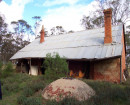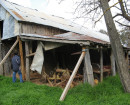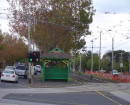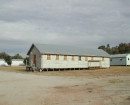WARRAGUL DRILL HALL
40 ALFRED STREET WARRAGUL, BAW BAW SHIRE
-
Add to tour
You must log in to do that.
-
Share
-
Shortlist place
You must log in to do that.
- Download report


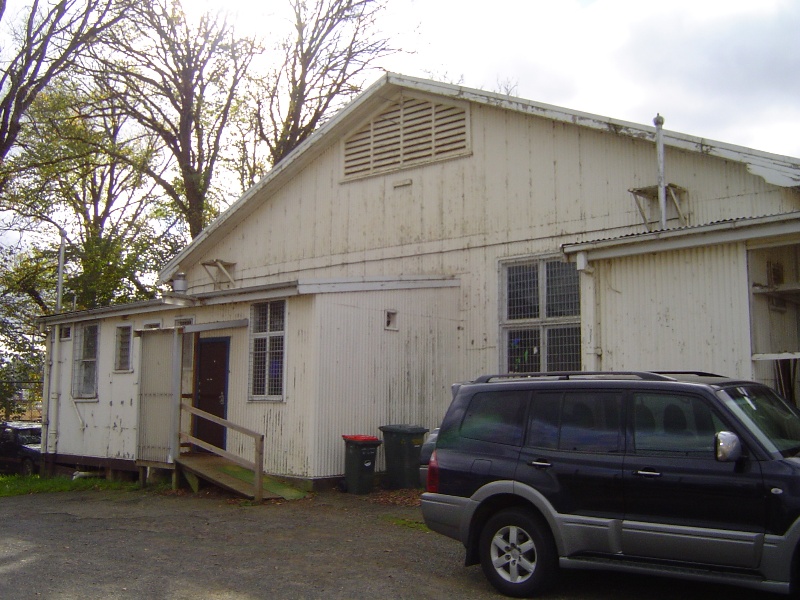

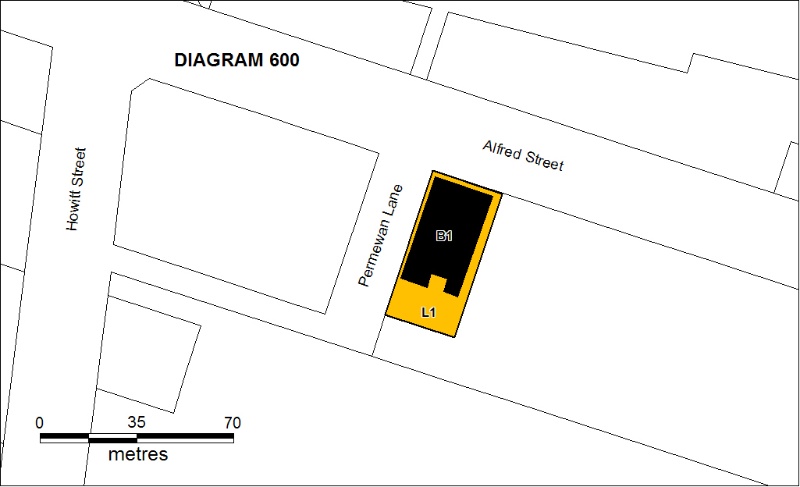
Statement of Significance
What is significant?
Warragul Drill Hall, built 1912-13, was the first of about forty timber and iron drill halls built in Victoria between 1912 and 1916 and was the prototype for all of this type built in Australia following the introduction of compulsory universal military training in 1911. The drill hall is a timber-framed, corrugated iron clad building with an iron roof, semi-circular ridge vents, and steel trusses. There is a timber louvre vent in the gable at each end of the hall. The building comprises a major hall space and a skillion section along the east side with nine small rooms designed as offices and stores which have since had their partition walls removed. In 1939 a timber floor was laid over the building's original asphalt floor. The drill hall has been owned by the Shire of Baw Baw since 1995.
Commonwealth architect John Smith Murdoch was probably responsible for the generic design, apparently developed from Queensland models, in response to the Minister for Defence's stipulation that "the cost of drill halls was to be put down to bedrock". Although the drawings for the Warragul Drill Hall were signed by Thomas Hill, Works Director, and Horace J Mackennal, draftsman of the Victorian Public Works Branch of the Commonwealth Department of Home Affairs, Murdoch had ultimate design responsibility.
Warragul Shire Council donated a block of land adjoining the showground and recreation reserve and on 13 August 1913 the Warragul Drill Hall was opened, the first of its type in Australia. Built originally for the Warragul, Drouin and Trafalgar area to house the 46th Infantry, 13th Light Horse and 45th Cadets, the drill hall has been home to a number of units. It also served as a recruiting centre during both world wars, a prisoner of war control centre from 1944 to 1946, a sports facility, and is currently used for gymnastics classes.
How is it significant?
Warragul Drill Hall is of historical and architectural significance to the State of Victoria.
Why is it significant?
Warragul Drill Hall is of historical significance as the first drill hall to be built in the Commonwealth after the introduction of compulsory universal military training in 1911. It is of historical significance as a building constructed as part of the nation's build up of military infrastructure just prior to World War I.
Warragul Drill Hall is of architectural significance as an essentially intact and representative example of the timber and iron drill halls designed by the Works Branch of the Commonwealth Department of Home Affairs between 1912 and 1916. It demonstrates its original drill and military administrative functions, through the planning of its internal spaces. The utilitarian design reflects the urgent need and high demand for this type of drill hall during this period and is in contrast to the more ornate colonial orderly rooms of the late nineteenth century and the stylish Art Deco models of the 1930s.
-
-
WARRAGUL DRILL HALL - History
History prepared by Ron Blair
President of RSL Warragul sub-branch
May 2000
WARRAGUL DRILL HALL
ALFRED STREET, W ARRAGUL
OPENED 13 AUGUST 1913
Restructuring of the Australian Commonwealth Military Forces on 28 May 1912 (Vazenry, GR. Military Forces of Victoria 1854-1967) and the introduction of compulsory military training highlighted the need for additional training depots -Drill Halls -in suitable locations. In some areas detachments of military units, including those in the Warragul Shire were forced to drill in the streets, or nearby paddocks. Warragul members of the Australian Natives Association (ANA) recognized the hardships these men and cadets were experiencing and in due course called a public meeting for Thursday 12 June 1912 (Warragul Guardian 17/6/1912). At this meeting a committee presided over by Cr. H E Dorrel was elected and a deputation appointed to approach the Warragul Shire Council to lobby for the construction of a Drill Hall at Warragul.
The deputation was successful, and as a result council purchased a portion (1 Rood 17.1 Perches) of Skewes and Hunter's sale-Yards at the corner of Alfred Street and Show Grounds Avenue, on the proviso that the land was not to be used as a sale-yard, or any similar activity (Copeland, H. Path of Progress, p 528). Notification of the transfer of the land to the Department of Defence was published in the Commonwealth Gazette No. 77 of 30 November 1912.
Several weeks later, a deputation comprising the Shire President, Councillors Count E K Von Horn and H Copeland, Messrs H T Taylor (ANA), E J Hunter (Agricultural Society), B J Dunn (Progress Association) and Dr. H F Hayes (Warragul Rifle Club), supported by the Honourable W H Irvine, met with the Minister for Defence, Senator George Pearce and offered the land as a donation to the Defence Department; it was immediately accepted. Timing of the deputation was impeccable, for just prior to the offer being made, the Federal Government allocated an amount of £80,000 (Warragul Guardian 15/8/1912 ) for the purchase of land and the construction of Drill Halls throughout Australia. Consequently, the offer made by the Warragul Shire, the first ever made by a community to assist the Defence Department, was considered patriotism at its best.
Representatives of the Defence Department and the Minister for Home Affairs, Mr. King O'Malley, subsequently inspected the land and reported on its suitability. Within days of the inspection, Mr. O'Malley forwarded a letter of acceptance to the Shire President:
?Permit me to convey to you my appreciation of the patriotic spirit which prompted yourself and councillors to adopt this generous, practical, and public spirited means of assisting the Department of Defence in their endeavour to provide adequate facilities for the training of our troops.?The original plan of the Defence Department was to build a Type 1 Drill Hall at Warragul, but in acknowledgment of the generosity of local residents and the number of troops expected to use the hall, settled on a Type 2 design; a larger, more expensive building costing in excess of £2,000 (Copeland, H. Path of Progress, p.528-9).
When the hall was nearing completion, the Shire President, Mr. Hugh Copeland, called a public meeting to organize the opening celebration; joint secretaries of that committee were Major Charles Ogilvy and Mr. Horatio Stevenson.
Wednesday 13 August 1913 was chosen as the date for the opening and arrangements made, including the official invitation list which included Captain T J Riley (Royal Australian Field Artillery Band), Captain Toby, Captain J M Durrant (Brigade Major, 12 Brigade), Mr. Donald McDonald, Presidents of the adjoining shires, Senator George Pearce, Senator Blakley, the Honourable W H Irvine, Mr. Bennett (MHR), Mr. Mackie (MLA), Mr. G J Crook (MLC), and prominent townspeople.
The opening of the Warragul Drill Hall was an important mile-stone in the military history of Gippsland, indeed Australia. It was the first Drill Hall built by the Commonwealth Government, and the first to be built on land donated by the people of a Shire to that Government. Furthermore, it was a Drill Hall of modified design and intended as a show piece for the military.
Warragul was selected before other towns and cities in Australia for two main reasons -its fine patriotic gesture, and its unprecedented commitment to the nation's future defence. A decision which established Warragul as the military centre of the district.
On the day of the opening, the Royal Australian Field Artillery Band, under the command of Captain T J Riley, arrived on the morning train in company with Colonel J W Parnell (Commandant, 3 Military District), Captain J M A Durrant (Brigade Major, 12 Brigade), Captain Gordon, Lieutenant F Thornwaite (Royal Australian Field Artillery), and Senator Pearce. They were welcomed by Major C S Ogilvy and other officers of local detachments and after a brief welcoming speech, were introduced to the Shire President, Cr. Hugh Copeland, Councilors, and prominent citizens.
The celebration began at 2pm, with the Warragul and Drouin detachments of A Squadron, 13th (Gippsland) Light Horse; G Company 48th (Kooyong) Infantry Battalion, and A Company, 45th Battalion Senior Cadets marching from the Warragul Post Office to the show grounds where they were inspected by Colonel Parnell.
After taking the salute, Colonel Parnell led the troops and the spectators to the drill hall, where he, Senator Pearce, and other guests were welcomed by the Shire President.
In a brief reply, Colonel Parnell expressed regret that the Minister of Defence was unable to be present, and added: ?Warragul should not only be proud of the fine drill hall, but even prouder of the lads and men they had to fill it. This is the first hall to be opened under the new regulations and Warragul was to be heartily congratulated on the fact; as well as the knowledge that an example had been set by them which other centres have followed.?
Since opening, the Warragul Drill Hall has been home to 'A' Squadron, 13 (Gippsland) Light Horse Regiment; 'A' Company, 45 Battalion Senior Cadets; 'F' Company 46 Infantry Battalion (Brighton Rifles); 'G' Company, 48 (Kooyong) Infantry Battalion; 52 (The Gippsland Regiment) Infantry Battalion; HQ South-Eastern Group VDC; 'A' Company, 11 Battalion (VDC); 2 Field Regiment (RAA); 31 Medium Regiment (RAA); 2 Recovery Company (RAEME); 1 and 3rd Recovery Platoons (RAEME). The Warragul Drill Hall has also served as a recruiting centre during both world wars, Prisoner of War control centre 1944-1946, a sports facility for basket ball, table tennis, badminton, a miniature rifle range, and a clothing factory. And at the time of writing it is being used for gymnastic classes.
Further research by Heritage VictoriaDuring this period drill halls were constructed to only two basic designs and varied only in size. None of the Type 1 designs survive and about 18 survive of the Type 2 designs. The very first of these new type drill halls in Australia was constructed in Warragul, Victoria from late-1912 to 1913. John Smith Murdoch giving evidence to the Parliamentary Works Committee 11 March 1915 noted:
The Minister of Defence laid down the principle that we were to put the cost of drill halls down to bedrock, there being so many required ; and those drill halls are made of wood and iron and are found good enough.
Military units in Warragul Shire trained in the streets and paddocks until a deputation was made to the Shire Council in June 1912 to lobby for the construction of a drill hall. Council purchased a portion of Skewes and Hunter's saleyards at the corner of Alfred Street and Showgrounds Avenue. The transfer of land to the Department of Defence was gazetted on 30 November 1912. A deputation of councillors and other Warragul citizens met with the Minister for Defence offering the land as a donation to the Defence Department. This offer was accepted and was considered a fine patriotic gesture. The department had just allocated £80,000 for the purchase of land and the construction of drill halls around Australia. The Commonwealth adopted the name Drill Halls in its World War 1 building program which commenced in 1913, using a standard set of design documents. The government's requirements were explained by Senator Pearce, Minister for Defence who was setting aside £80,000 in the Works Estimates:
There will be two types of drill halls - a closed-in type for the colder climates, and a hall with one side open for tropical or semi-tropical climates. There will also be two classes of halls, respectively, 150ft x 50ft and 100ft x 50ft with the necessary offices and stores attached. They will be constructed of galvanised iron, with tar paved or wooden floor, the offices and storerooms being lined and ceiled. For a first class building the minimum area of land required is 200ft x 100ft and for the other class 150ft x 100ft, the extra space in each case being required for conveniences, etc, outside the building. (The Argus, 27 September 1912).
Senator Pearce also noted in The Argus 27 September 1912 that: Warragul was the first body to come forward with a concrete proposal is the Warragul Shire Council, which has offered the fee simple of a block of land 86ft x 180ft adjoining the showground and recreation reserve. The work of erecting a second class drill hall on this allotment will be commenced within a few weeks. It was for the Warragul, Drouin and Trafalgar area to house the 46th Infantry, 13th Light Horse and 45th Cadets.
The formal opening of the Warragul Drill Hall was on 13 August 1913 and performed by the State military commandment Colonel Parnell. It was declared in the Argus (14 August 1913) that it was the first to be built in the Commonwealth under the new defence scheme. The drill hall was built at a cost of £1250 and is conveniently situated near the railway station.
The plan was dated 31 January 1913 and signed by Horace J MacKennal, Director of Works, Commonwealth Department of Interior in the post - Federation/pre World War I era. MacKennal also designed the former South Melbourne Post Office VHR H1771. The Warragul Drill hall was a Type 2 design, a larger, more expensive building costing in excess of £2000.
The building originally had a tar paved floor but a new floor laid over it in 1939.
The opening ceremony for the hall was held on 13 August 1913 and was an important milestone in the military history of Gippsland. Colonel Parnell, Commandant, 3 Military District, stated in his speech that the Warragul hall was the first hall to be opened under the new regulations.
The Warragul Drill Hall has been home to A Squadron, 13 (Gippsland) Light Horse Regiment; A Company, 45 Battalion Senior Cadets; F Company 46 Infantry Battalion (Brighton Rifles); G Company, 48 Infantry Battalion; 52 (The Gippsland Regiment) Infantry Battalion; HQ South-eastern Group VDC; A Company, 11 Battalion (VDC); 2 Field Regiment (RAA); 31 Medium Regiment (RAA); 2 Recovery Company (RAEME); 1 and 3rd Recovery Platoons (RAEME). It also served as a recruiting centre during both world wars, Prisoner of War control centre 1944-46, a sports facility, a miniature rifle range and a clothing factory. It is currently used for gymnastic classes.
All 40 in Victoria were essentially identical in design although some were longer than others. They featured vertical corrugated iron cladding over a timber frame (except for Footscray which is horizontally laid), and distinctive semi-circular ridge vents characteristic of their Queensland origins. Passchendaele Barracks, Bendigo another example of the type, has the characteristic features of the design. It was recommended for local planning protection by the Heritage Council in 2004.
Plans held at National Archives. Series B3712, Barcode Number 12260952, Drawer 122 Folder 15: Plan dated 31 January 1913 signed by Works Director Victoria; Alterations, additions and sewerage plan drawn by DJ Armishaw, Works Director Victoria, undated; new floor, 1939.
WARRAGUL DRILL HALL - Plaque Citation
Built in 1912-13, this was the first of many timber and iron drill halls constructed in Australia between 1912 and 1916 following the introduction of compulsory universal military training in 1911.
WARRAGUL DRILL HALL - Permit Exemptions
General Exemptions:General exemptions apply to all places and objects included in the Victorian Heritage Register (VHR). General exemptions have been designed to allow everyday activities, maintenance and changes to your property, which don’t harm its cultural heritage significance, to proceed without the need to obtain approvals under the Heritage Act 2017.Places of worship: In some circumstances, you can alter a place of worship to accommodate religious practices without a permit, but you must notify the Executive Director of Heritage Victoria before you start the works or activities at least 20 business days before the works or activities are to commence.Subdivision/consolidation: Permit exemptions exist for some subdivisions and consolidations. If the subdivision or consolidation is in accordance with a planning permit granted under Part 4 of the Planning and Environment Act 1987 and the application for the planning permit was referred to the Executive Director of Heritage Victoria as a determining referral authority, a permit is not required.Specific exemptions may also apply to your registered place or object. If applicable, these are listed below. Specific exemptions are tailored to the conservation and management needs of an individual registered place or object and set out works and activities that are exempt from the requirements of a permit. Specific exemptions prevail if they conflict with general exemptions. Find out more about heritage permit exemptions here.Specific Exemptions:General Conditions: 1. All exempted alterations are to be planned and carried out in a manner which prevents damage to the fabric of the registered place or object. General Conditions: 2. Should it become apparent during further inspection or the carrying out of works that original or previously hidden or inaccessible details of the place or object are revealed which relate to the significance of the place or object, then the exemption covering such works shall cease and Heritage Victoria shall be notified as soon as possible. General Conditions: 3. If there is a conservation policy and plan endorsed by the Executive Director, all works shall be in accordance with it. Note: The existence of a Conservation Management Plan or a Heritage Action Plan endorsed by the Executive Director, Heritage Victoria provides guidance for the management of the heritage values associated with the site. It may not be necessary to obtain a heritage permit for certain works specified in the management plan. General Conditions: 4. Nothing in this determination prevents the Executive Director from amending or rescinding all or any of the permit exemptions. General Conditions: 5. Nothing in this determination exempts owners or their agents from the responsibility to seek relevant planning or building permits from the responsible authorities where applicable. Minor Works : Note: Any Minor Works that in the opinion of the Executive Director will not adversely affect the heritage significance of the place may be exempt from the permit requirements of the Heritage Act. A person proposing to undertake minor works may submit a proposal to the Executive Director. If the Executive Director is satisfied that the proposed works will not adversely affect the heritage values of the site, the applicant may be exempted from the requirement to obtain a heritage permit. If an applicant is uncertain whether a heritage permit is required, it is recommended that the permits co-ordinator be contacted.
Exterior
Demolition or removal of outbuildings and sheds.
Repair, removal or replacement of fences and gates.
Removal of extraneous items such as air conditioners, pipe work, ducting, wiring, antennae, aerials etc, and making good.Interior
Painting of previously painted surfaces provided that preparation or painting does not remove evidence of the original paint or other decorative scheme.
Installation, removal or replacement of carpets and or flexible floor coverings.
Installation, removal or replacement of curtain track, rods, blinds and other window dressings.
Installation, removal or replacement of hooks, nails and other devices for the hanging of mirrors, paintings and other wall mounted artworks.
Refurbishment of bathrooms and toilets including removal, installation or replacement of sanitary fixtures and associated piping, mirrors, wall and floor coverings.
Installation, removal or replacement of kitchen benches and fixtures including sinks, stoves, ovens, refrigerators, dishwashers etc and associated plumbing and wiring.
Installation, removal or replacement of ducted, hydronic or concealed radiant type heating provided that the installation does not damage existing skirtings and architraves and provided that the location of the heating unit is concealed from view.
Installation, removal or replacement of electrical and telecommunications wiring provided that all new wiring is fully concealed
Installation, removal or replacement of bulk insulation in roof spaces.
Installation, removal or replacement of smoke detectors.
Installation, removal or replacement of electric clocks, public address systems, detectors, alarms, emergency lights, exit signs, luminaires and the like on plaster surfaces.
Installation of new fire hydrant services including sprinklers, fire doors and elements affixed to plaster surfaces.WARRAGUL DRILL HALL - Permit Exemption Policy
The purpose of the permit exemptions is to allow works that do not impact on the heritage significance of the place to occur without the need for a permit. Alterations which impact on the significance of this structure are subject to permit applications.
The cultural heritage significance of the Warragul Drill Hall is principally due to its historical and architectural significance as the earliest and one of the most intact of the First World War era drill halls. The large internal volume should be retained as should the flanking office spaces although they could be refurbished.
-
-
-
-
-
WARRAGUL RAILWAY STATION
 Victorian Heritage Register H1598
Victorian Heritage Register H1598 -
WARRAGUL POLICE RESERVE
 Victorian Heritage Inventory
Victorian Heritage Inventory -
FORMER WARRAGUL TIP SITE
 Victorian Heritage Inventory
Victorian Heritage Inventory
-
'NORWAY'
 Boroondara City
Boroondara City -
1 Mitchell Street
 Yarra City
Yarra City
-
-




